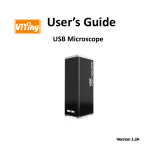
WORK MORE EFFICIENTLY IN DEVELOPMENTAL BIOLOGY WITH STEREO MICROSCOPY:
FRUIT FLIES
(DROSOPHILA)
10
Leica Microsystems (Switzerland) Ltd. · Max-Schmidheiny-Strasse 201· 9435 Heerbrugg, Switzerland
T +41 71 726 34 34 · F +41 71 726 34 44
www.leica-microsystems.com
Copyright © 2015 Leica Microsystems (Schweiz) AG. All rights reserved. Subject to modifications.
LEICA and the Leica Logo are registered trademarks of Leica Microsystems IR GmbH. FusionOptics is a trademark of Leica Microsystems (Schweiz) AG registered in Europe.
References / Additional Reading
1.
G. Manning, A quick and simple introduction to
Drosophila melanogaster, Drosophila
Virtual Library
2.
Thomas H. Morgan – Biographical, The Nobel Prize in Physiology or Medicine 1933, The Nobel Foundation, Stockholm, Sweden
3.
Chromosomes, National Human Genome Research Institute (NHGRI), National Institute of Health (NIH), Bethesda, Maryland, USA
4.
Mutation, Talking Glossary of Genetic Terms, National Human Genome Research Institute (NHGRI), National Institute of Health
(NIH), Bethesda, Maryland, USA
5.
Deletion, Talking Glossary of Genetic Terms, National Human Genome Research Institute (NHGRI), National Institute of Health
(NIH), Bethesda, Maryland, USA
6.
Genome, Talking Glossary of Genetic Terms, National Human Genome Research Institute (NHGRI), National Institute of Health
(NIH), Bethesda, Maryland, USA
7.
L.T. Reiter, L. Potocki, S. Chien, M. Gribskov, E. Bier, A Systematic Analysis of Human Disease-Associated Gene Sequences In
Drosophila melanogaster
, Genome Res., vol. 11, iss. 6 (June, 2001) pp. 1114–1125; doi: 10.1101/gr.169101
8.
J. Herrero, How to get all the orthologous genes between two species, Ensembl Project, Cambridge, UK
9.
F. Hoff, How to Prepare Your Specimen for Immunofluorescence Microscopy, Science Lab
10.
Phenotype, Talking Glossary of Genetic Terms, National Human Genome Research Institute (NHGRI), National Institute of Health
(NIH), Bethesda, Maryland, USA
11.
D. Goeggel, The History of Stereo Microscopy – Part III: The 19th Century – Breakthrough of Modern Microscope Manufacturing,
Science Lab
12.
D. Goeggel, The History of Stereo Microscopy – Part II: The 18th Century – Greater Demands are Placed on Optics, Science Lab
13.
Objective Classes, Leica Microsystems
14.
R. Rottermann, P. Bauer, How Sharp Images Are Formed: Depth of Field in Microscopy, Science Lab
15.
D. Goeggel, Factors to Consider When Selecting a Stereo Microscope, Science Lab
16.
Genotype, Talking Glossary of Genetic Terms, National Human Genome Research Institute (NHGRI), National Institute of Health
(NIH), Bethesda, Maryland, USA
17.
C. Greb, Fluorescent Proteins – Introduction and Photo Spectral Characteristics, Science Lab
18.
Sharyn A. Endow, Detecting Gene Expression in
Drosophila
, Application Notes, Leica Biosystems
19.
D. Goeggel, A. Schué, D. Kiper, FusionOptics – Combines high resolution and depth of field for ideal 3D optical images, Science Lab
20.
I. Maimon, L. Gilboa, Dissection and Staining of
Drosophila
Larval Ovaries, Jove, doi: 10.3791/2537
21.
J. De Bock, Mosaic Images: Bringing Together What Belongs Together, Science Lab
CONNECT
WITH US!












